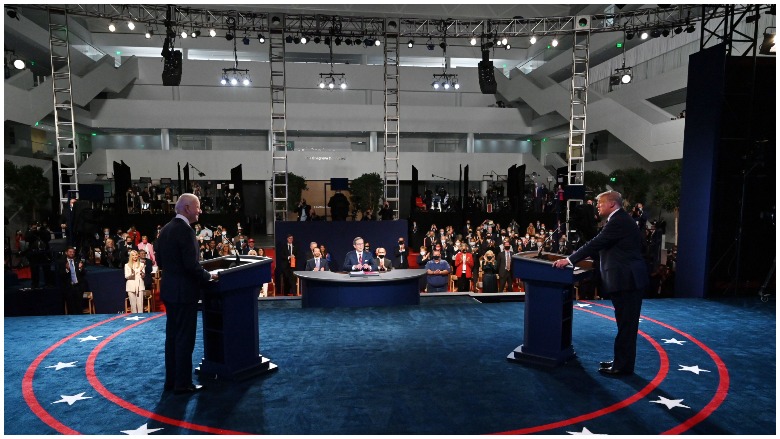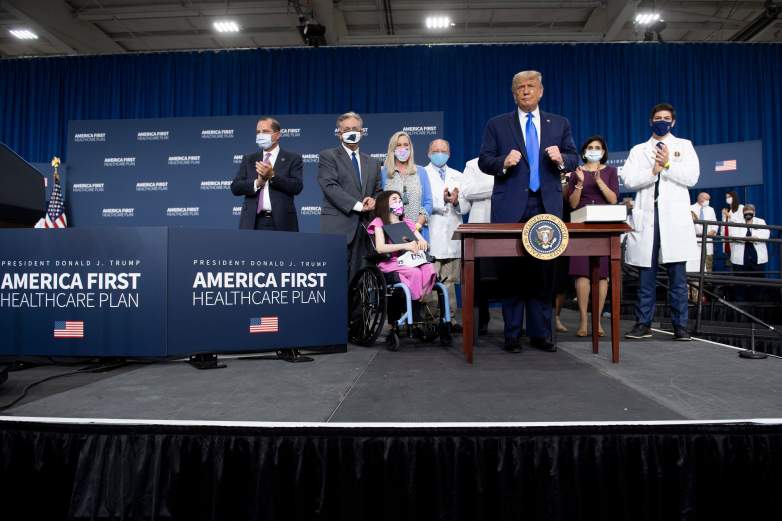
During the first 2020 presidential debate on Tuesday, September 29, President Donald Trump interrupted former Vice President Joe Biden while he made a point about health care and the Supreme Court, and said that Biden’s claim that 100 million Americans qualify as having pre-existing conditions was “totally wrong.”
It was the first exchange of the evening and set the tone for 90 minutes of shouting, interruptions and personal attacks, which moderator Chris Wallace tried to keep under control.
But was Trump or Biden correct on pre-existing conditions? Here’s what you need to know:
According to the U.S. Department of Health & Human Services, Around 133 Million Americans Have Qualifying Pre-Existing Conditions
Biden and Trump were asked by moderator Chris Wallace about the direction of the Supreme Court, in light of Trump’s nomination of conservative Judge Amy Coney Barrett to fill the late Justice Ruth Bader Ginsburg’s seat.
Biden raised the concern that more than 100 million people might be denied health insurance, should a conservative-majority Supreme Court strike down the Affordable Care Act in its entirety, and said that a Supreme Court nomination and confirmation should wait until the next president is seated.
Trump said, “There aren’t 100 million people with pre-existing conditions,” and told Biden that the voters had “already had their say,” with regards to fast-tracking a Supreme Court confirmation.
“One hundred million people is totally wrong,” Trump added. “I don’t know where you got that number. The bigger problem you have is that you’re going to extinguish 180 million people with their private health care that they’re happy with.”
The Biden campaign and Democratic National Committee Twitter account Truth countered Trump’s claim immediately, citing a New York Times article. “There are 133 million” Americans with pre-existing conditions, the campaign wrote.
Data collected by DHHS does indeed indicate that up to 133 million non-elderly Americans — that’s roughly 23% of all citizens — have pre-existing conditions that could cause them to be denied health coverage or coverage at an “exorbitant price” before the ACA reforms that went into effect in 2014. You can read the entire DHHS report here.
Trump Signed an Executive Order Last Week He Said Would Guarantee Coverage for Pre-Existing Conditions — Something Already Contained in the Affordable Care Act

Getty/Brendan SmialowskiPresident Trump signed an executive order on health care on September 24, 2020, in Charlotte, North Carolina.
Last week in Charlotte, North Carolina, Trump signed an executive order that he said would enshrine the rights of any American with pre-existing conditions to get affordable health coverage.
Trump called the order “historic” and said he was signing it in response to Democrats’ concerns about his attempts to abolish the ACA, the Washington Post reported.
“The historic action I’m taking today includes the first-ever executive order to affirm it is the official policy of the United States government to protect patients with preexisting conditions,” Trump said. “We’re making that official. We’re putting it down in a stamp, because our opponents, the Democrats, like to constantly talk about it.”
However, protection for people with pre-existing conditions is already a widely-known part of the ACA legislation. And public health experts said that the executive order was mostly symbolic, and would essentially mean nothing if the Supreme Court were to strike down the ACA entirely, the non-profit Kaiser Health Network reported.
“Were the court to hold the ACA unconstitutional, the executive order would still do nothing, because it has no enforcement power,” Indiana University health law professor David Gamage told KHN.
The Trump campaign’s war room Twitter account went after a number of Biden’s claims during Tuesday night’s debate, including on health care. Trump’s camp said that Biden’s proposed public option for people who cannot afford insurance would “kill the private insurance plans held by millions of Americans.” The campaign did not back up Trump’s assertion that fewer than 100 million Americans have pre-existing conditions.
READ NEXT: Trump Falsely Claims He Has Only Held Outdoor Campaign Rallies During COVID-19